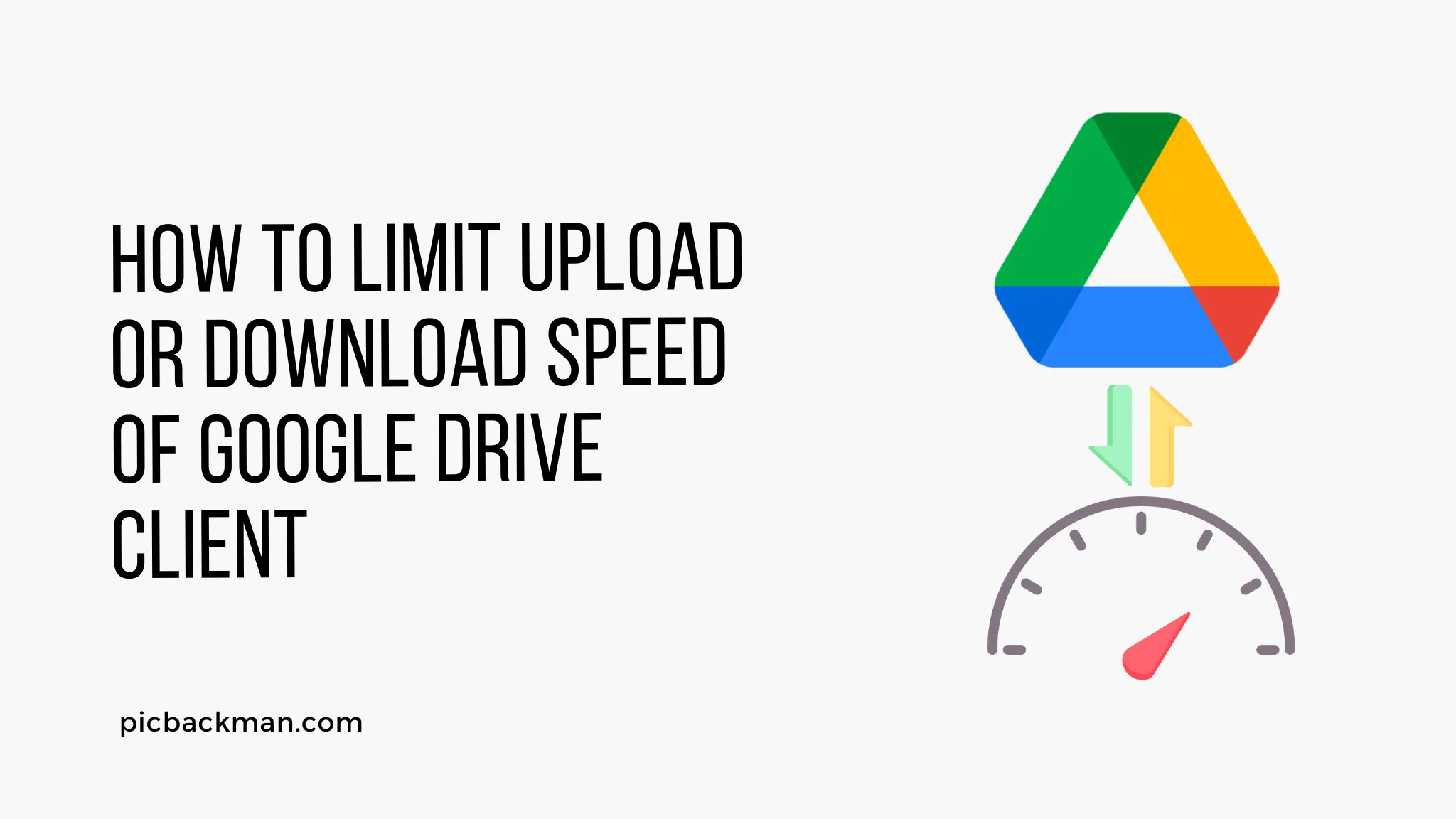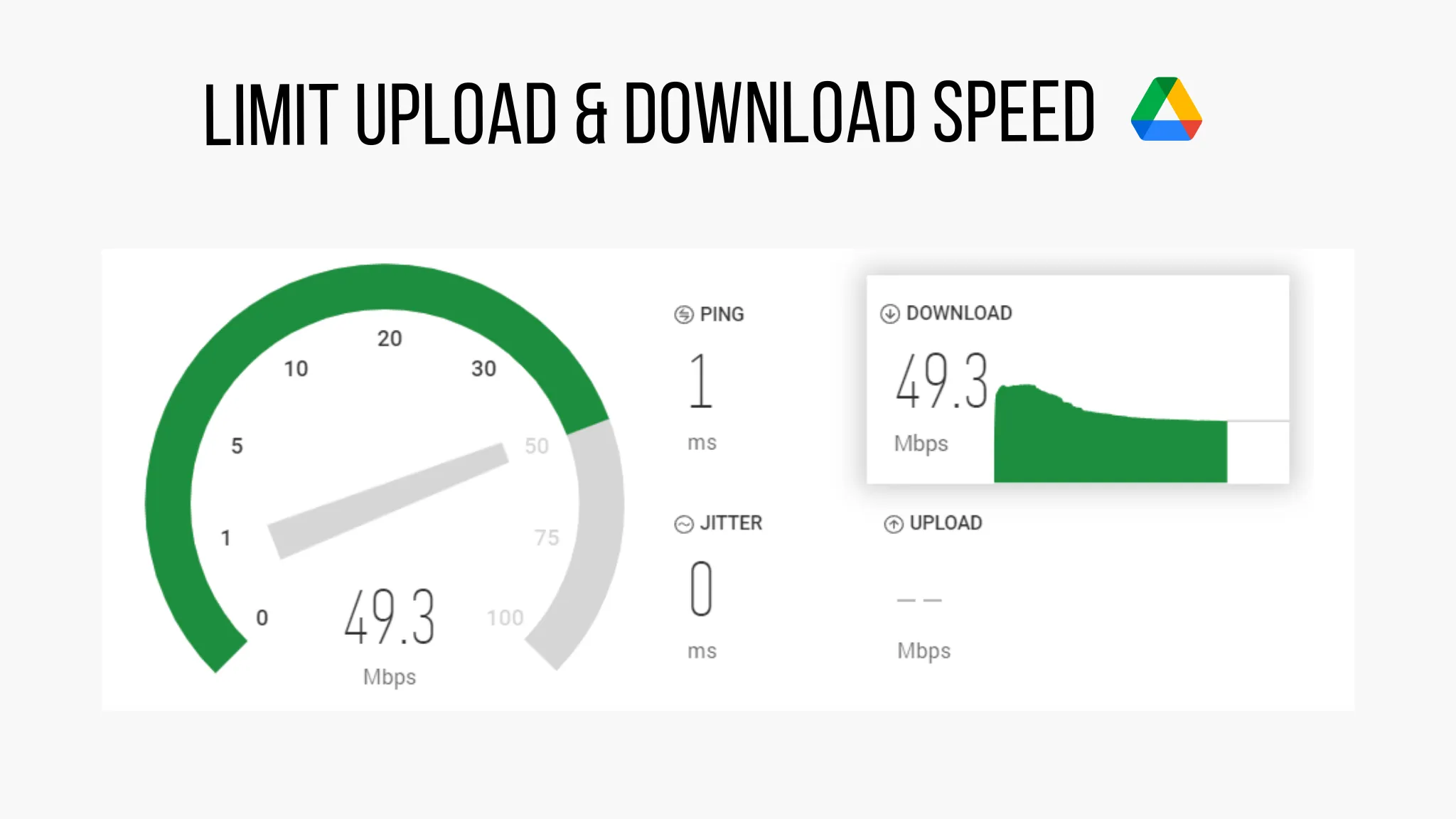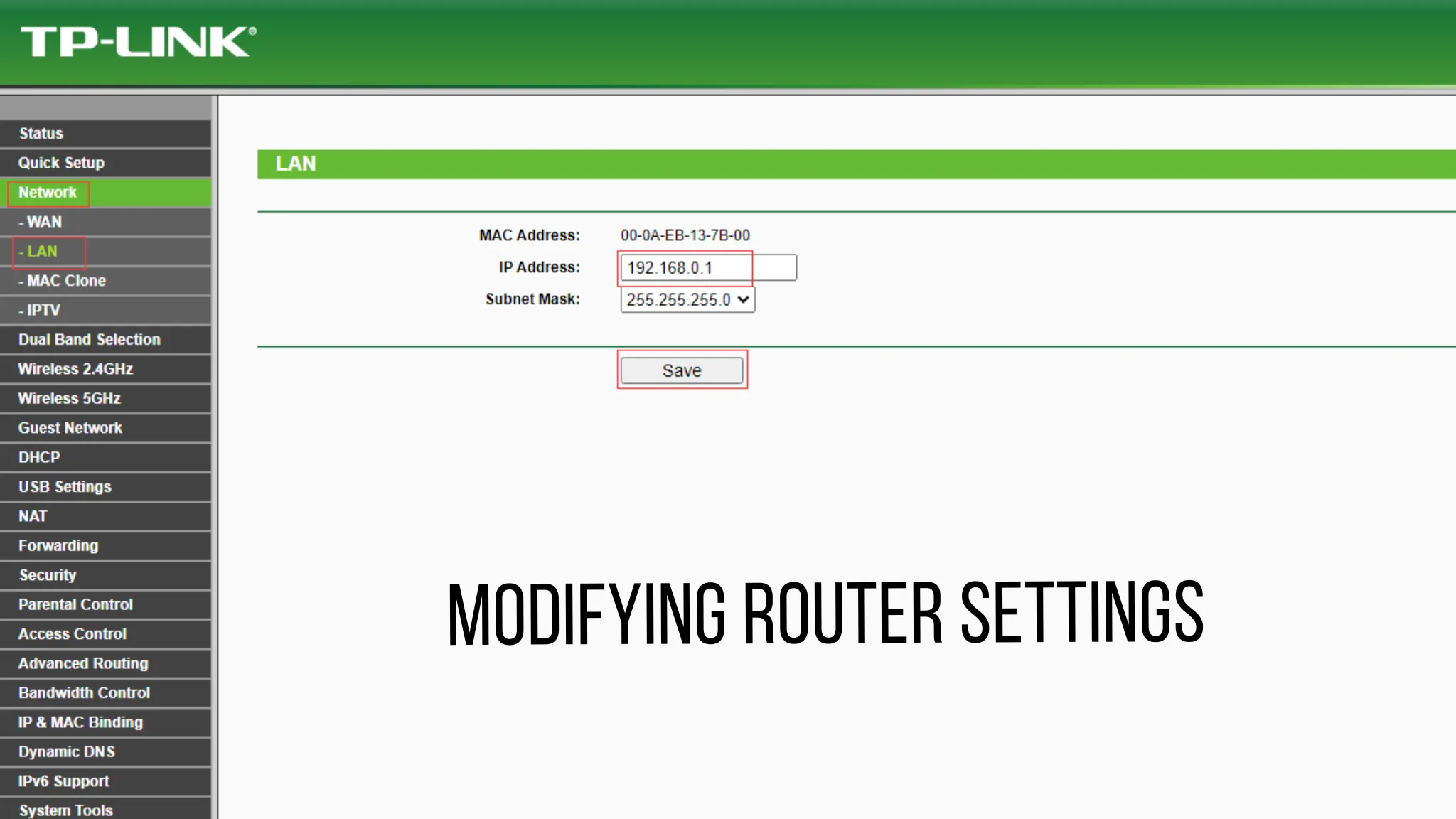
Why is it the #1 bulk uploader?
- Insanely fast!
- Maintains folder structure.
- 100% automated upload.
- Supports RAW files.
- Privacy default.
How can you get started?
Download PicBackMan and start free, then upgrade to annual or lifetime plan as per your needs. Join 100,000+ users who trust PicBackMan for keeping their precious memories safe in multiple online accounts.
“Your pictures are scattered. PicBackMan helps you bring order to your digital memories.”
How to Limit Upload or Download Speed of Google Drive Client?


Google Drive is a popular cloud storage platform that allows users to store, access, and share their files seamlessly across various devices.
While it offers convenience and flexibility, there may be instances when you need to control the upload or download speed of the Google Drive client.
This article explores the methods to limit the upload or download speed, ensuring a smoother experience while managing your files in the cloud.
Google Drive client is a desktop application that synchronizes files between your computer and your Google Drive account. It constantly monitors for changes in files and folders, ensuring that the latest versions are available across all connected devices.
However, in certain scenarios, such as limited bandwidth or network congestion, it becomes necessary to limit the upload or download speed of the Google Drive client.
Managing the upload and download speed of Google Drive client is crucial for several reasons. It helps in efficient bandwidth management, preventing network congestion, and ensuring fair resource allocation among different applications and users sharing the same network.
Why limit upload/download speed? ⬇️

bandwidth management
By limiting the upload or download speed of Google Drive client, you can effectively manage your available bandwidth. This allows you to allocate resources to other essential tasks or applications that require a stable and consistent internet connection.
Preventing network congestion
In networks with multiple users, especially in shared environments like offices or educational institutions, limiting the upload/download speed of Google Drive client can prevent network congestion. This ensures that other users can access the internet and perform their tasks without experiencing slowdowns or latency.
Fair resource allocation
By controlling the upload or download speed of Google Drive client, you can ensure fair resource allocation across different devices and users. This prevents any single user or application from monopolizing the network bandwidth and guarantees a balanced experience for everyone.
Methods to limit upload/download speed
There are several methods available to limit the upload or download speed of Google Drive client. Let's explore three popular options:
Method 1: Using third-party software
Third-party software provides additional control and flexibility in managing the upload and download speed of Google Drive client. These software solutions often come with advanced features and customization options. Here's how you can use this method:
- Research and choose a reliable third-party software that offers bandwidth management features for Google Drive client.
- Download and install the software on your computer.
- Follow the software's instructions to configure the upload and download speed limits specific to the Google Drive client.
- Monitor the changes and adjust the settings as necessary.
Using third-party software allows you to have granular control over the upload and download speed of Google Drive client, but keep in mind that additional software may require system resources and might introduce complexity to your setup.
Method 2: Modifying router settings
If you have administrative access to your router, you can also limit the upload and download speed of the Google Drive client by modifying the router settings. Here's how you can proceed:
- Access your router's settings by typing its IP address into a web browser.
- Look for the Quality of Service (QoS) or Traffic Management settings within your router's configuration options.
- Configure the QoS settings to prioritize or limit the bandwidth allocated to Google Drive client.
- Save the changes and restart your router if necessary.
Backup & Transfer your Photos in Minutes
Trusted by users in 125+ countries.
Modifying the router settings provides a network-wide solution, ensuring that the upload and download speed of Google Drive client is limited for all connected devices. However, this method requires administrative access to the router and may vary depending on the router model.
Method 3: Limiting Google Drive client settings
Google Drive client itself offers options to limit the upload and download speed within its settings. Here's how you can utilize this built-in functionality:
- Open the Google Drive client on your computer.
- Access the settings menu within the client.
- Look for options related to upload and download speed or bandwidth allocation.
- Adjust the settings to your desired limits, taking into account your network capabilities and requirements.
- Save the changes, and the Google Drive client will adhere to the configured upload and download speed limits.
Utilizing the Google Drive client settings is the most straightforward method, as it does not require additional software installations or router configuration. However, the options available within the client might be more limited compared to the other methods.
Method 1: Using third-party software
One effective method to limit the upload and download speed of Google Drive client is by using third-party software specifically designed for bandwidth management. These software solutions provide enhanced control and customization options to meet your specific requirements.
To get started with this method, you need to research and select a reliable third-party software that offers bandwidth management features for Google Drive client. Look for software that provides the necessary tools to configure upload and download speed limits, monitor network usage, and adjust settings as needed.
Once you have chosen the software, follow these general steps to install and configure it:
- Download the selected third-party software from the official website.
- Run the installation file and follow the on-screen instructions to install the software on your computer.
- Launch the software and navigate to the settings or preferences section.
- Locate the options related to Google Drive or cloud storage services.
- Configure the upload and download speed limits according to your desired values. You may have the option to set maximum speeds or allocate specific percentages of your available bandwidth.
- Save the changes and ensure that the software is running in the background.
Using third-party software for managing the upload and download speed of Google Drive client offers several benefits. These solutions often provide advanced features such as scheduling, prioritization, and detailed reporting.
However, keep in mind that each software may have its own unique interface and configuration steps.
It's important to consider the limitations of this method as well. Some third-party software options might require a subscription or have compatibility issues with certain operating systems.
Additionally, running additional software in the background can consume system resources, potentially affecting the overall performance of your computer.
Method 2: Modifying router settings

Another effective way to control the upload and download speed of Google Drive client is by modifying the settings of your router. This method allows you to manage the bandwidth allocation at the network level, ensuring that all devices connected to the router adhere to the specified limits.
To proceed with this method, follow these general steps:
- Open a web browser on a device connected to the same network as your router.
- Enter the IP address of your router in the browser's address bar. The IP address is typically mentioned in the router's documentation or printed on the device itself.
- Press Enter, and you should be redirected to the router's configuration page.
- Authenticate yourself by entering the router's username and password. If you haven't changed these credentials, consult the router's manual or contact your internet service provider for the default login details.
- Locate the Quality of Service (QoS) or Traffic Management section within the router's configuration options. The exact location and labeling may vary depending on your router model and firmware version.
- Enable QoS or Traffic Management if it's not already enabled.
- Configure the upload and download speed limits for the Google Drive client or prioritize other applications over it, depending on your router's options. Some routers allow you to set specific limits in terms of kilobits per second (Kbps) or percentage of total bandwidth.
- Save the changes and restart your router if necessary.
Modifying the router settings to limit the upload and download speed of Google Drive client provides a network-wide solution. This means that all devices connected to the router, including computers, smartphones, and tablets, will have their Google Drive client speed restricted.
However, it's important to note that accessing router settings requires administrative access. If you are in a shared environment or using a router provided by your internet service provider, you may need to consult with the network administrator or contact your service provider for assistance.
Additionally, the options and interface for configuring QoS or Traffic Management settings can vary significantly depending on the router model and firmware version. Therefore, it's advisable to refer to the router's documentation or online resources specific to your router model for detailed instructions.
Method 3: Limiting Google Drive client settings
Google Drive client itself provides options to limit the upload and download speed without the need for third-party software or router modifications. By utilizing the built-in settings of Google Drive client, you can conveniently control the speed of file synchronization to suit your network capabilities and requirements.
To limit the upload and download speed using Google Drive client settings, follow these steps:
- Open the Google Drive client on your computer. You can usually find it in the system tray (Windows) or menu bar (macOS).
- Click on the settings icon or navigate to the preferences section within the client.
- Look for options related to upload and download speed or bandwidth allocation. These options might be available under a "Sync" or "Network" tab.
- Adjust the settings to your desired limits. You may have the option to set maximum upload and download speeds in terms of kilobits per second (Kbps) or megabits per second (Mbps).
- Additionally, explore the client settings to customize the sync preferences. You can choose to sync files on-demand, specify which folders to sync, or pause syncing temporarily if needed.
- Save the changes, and the Google Drive client will adhere to the configured upload and download speed limits.
Utilizing the Google Drive client settings is the most straightforward method, as it does not require any additional software installations or router configuration. The options available within the client allow you to easily adjust the speed limits according to your network capabilities and preferences.
However, it's important to consider the limitations of this method. The Google Drive client settings might provide more basic functionality compared to third-party software or router modifications. Advanced features such as scheduling or detailed reporting may not be available.
Best practices for limiting upload/download speed
When implementing any method to limit the upload or download speed of Google Drive client, it's essential to follow some best practices to ensure optimal performance and efficient resource utilization:
Analyzing network requirements
Before setting specific upload and download speed limits, it's crucial to analyze your network requirements. Consider the number of devices connected to your network, the available bandwidth, and the activities that require stable internet connections.
This analysis will help you determine appropriate speed limits that maintain a balance between Google Drive client performance and other network-dependent tasks.
Monitoring network usage
Regularly monitor your network usage to identify any potential bottlenecks or issues related to bandwidth allocation. Keep an eye on the data usage of Google Drive client and other applications that rely on the network. This monitoring will help you fine-tune the upload and download speed limits and adjust them as necessary.
Optimizing settings for efficient uploads/downloads
Experiment with different settings and configurations to find the most efficient upload and download speed limits for your specific needs. Consider factors such as file size, network latency, and synchronization frequency. Fine-tuning these settings will ensure that the Google Drive client operates smoothly while utilizing the available network resources optimally.
Quick Tip to Keep your Photos Safe
Making backups of your photos & videos is a chore you probably skip, but it really doesn't have to be hard. Here's an effortless way to backup photos - PicBackMan .
PicBackMan is the easiest and simplest way to keep your photos safely backed up in one or more online accounts. Simply download PicBackMan (it's free!) , register your account, connect to your online store and tell PicBackMan where your photos are - PicBackMan does the rest, automatically. It bulk uploads all photos and keeps looking for new ones and uploads those too. You don't have to ever touch it.
Conclusion
Limiting the upload or download speed of Google Drive client is essential for efficient bandwidth management, preventing network congestion, and ensuring fair resource allocation.
By utilizing methods such as third-party software, modifying router settings, or adjusting Google Drive client settings, you can have greater control over the synchronization speed while managing your files in the cloud.
Remember to analyze your network requirements, monitor network usage, and optimize settings for efficient uploads and downloads. By following these best practices, you can strike a balance between Google Drive client performance and the overall network experience.
Implement the method that best suits your needs, considering factors such as technical expertise, network environment, and available resources. Enjoy a smoother experience while using the Google Drive client without compromising on network performance.
FAQs (Frequently Asked Questions)
How do I cap upload speed on Google Drive?
To cap the upload speed on Google Drive, you can utilize methods such as using third-party software with bandwidth management features, modifying router settings, or adjusting the settings within the Google Drive client itself. Refer to the article for detailed instructions on each method.
How do I change my download speed on Google Drive?
Changing the download speed on Google Drive can be achieved by implementing similar methods as mentioned for capping upload speed. You can use third-party software, modify router settings, or adjust the Google Drive client settings to limit the download speed. Follow the instructions provided in the article for more information.
What is the Google Drive rate limiting exception?
The Google Drive rate limiting exception refers to the restrictions imposed by Google Drive on the number of API requests you can make within a specific time frame. Google Drive enforces rate limits to ensure fair usage and prevent abuse of the API. If you exceed the rate limits, you may encounter errors or temporary restrictions on your API usage.
What are Google API rate limits?
Google API rate limits are limitations set by Google for their various APIs, including the Google Drive API. These limits control the number of requests you can make to the API within a particular time period. The rate limits vary based on factors like the type of API, user type, and authentication method. Exceeding these limits may result in temporary restrictions on API usage.
How do I check my Google Drive storage limit?
To check your Google Drive storage limit, follow these steps:
- Open Google Drive in a web browser.
- Sign in to your Google account if you haven't already.
- Locate the storage indicator on the left side of the Google Drive interface.
- Hover over the storage indicator to view the total storage limit and the amount of storage currently used.
- You can also click on the storage indicator to access more details about your storage usage, purchase additional storage, or manage your storage settings.





